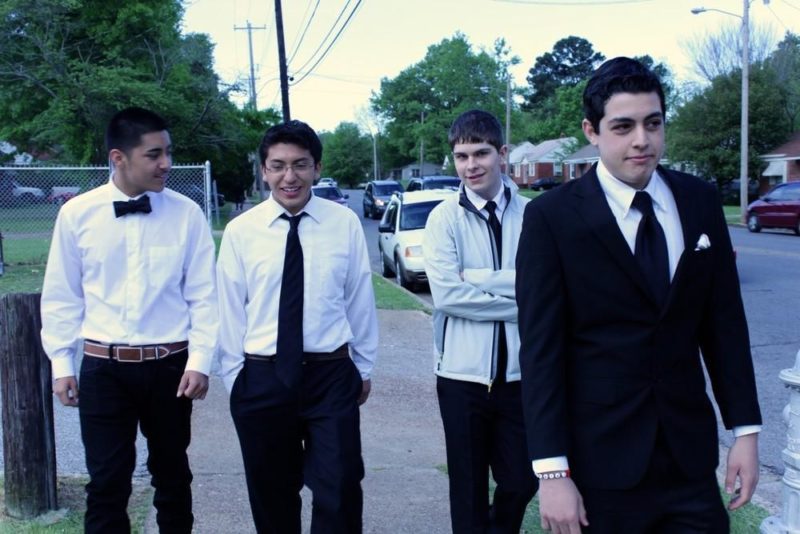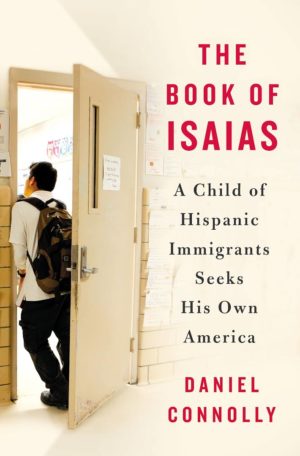 Isaias Ramos (second from left) walks with classmates to a ceremony honoring the top students at Kingsbury High School in Memphis, TN. (Photo courtesy of Daniel Connolly)
Isaias Ramos (second from left) walks with classmates to a ceremony honoring the top students at Kingsbury High School in Memphis, TN. (Photo courtesy of Daniel Connolly)
In the midst of all the rancor surrounding the debate over immigration - reaching new heights of vitriol and divisiveness in the 2016 presidential campaign season - it may be easy to forget that communities across the country, especially in their public schools, are working with many undocumented families to try to forge some path of success for their children.
Educators at Kingsbury High School in Memphis, TN., never saw Isaias Ramos as a "problem" or a "statistic" - he's just one of the best students they ever taught. Isaias' family came to this country in 2003 from Hidalgo, Mexico and settled in Memphis, where his parents would set up a small house-painting business. Isaias excelled at school, and in 2012, as he prepared for his senior year, he met Daniel Connolly, a reporter with the Memphis Commercial Appeal. Connolly, who had been covering immigration from Mexico to the American south for a decade, wanted to take a closer look at the lives of immigrant children. With the blessing of Isaias and his family and school administrators, Connolly spent the 2012-13 school year embedded in Kingsbury, tracking Isaias and some of his classmates as they navigated their way through the difficult senior year, and the educators who intervened to help them make the right choices about their future.
What began as an award-winning multimedia project for the Commercial Appeal evolved into "The Book of Isaias: A Child of Hispanic Immigrants Seeks His Own America," published in October by St. Martins Press. Connolly recently spoke with NEA Today about how the story of one teenager and his classmates illustrates why society must do more to help this generation of immigrant children meet their full potential.
Tell us about Memphis, specifically the changes immigration from Mexico has bought to the community and to Kingsbury High.
Daniel Connolly: In the 1950s, when Kingsbury was built, it was an all-White, segregated school. Every teacher, every student, every administrator was White in the school - everyone except probably the custodial staff. Then court-ordered busing in the 1970s came into play, and by the 1980s, the school was a mix of Black and White students. In the 1990s, we saw at Kingsbury and in Memphis generally, an increase of immigrants, from Mexico in particular.
But the type of changes I write about at this one school have taken place all across the U.S. For educators who are pretty much any school in America, their chances of teaching many students from immigrant families are much higher now obviously than they were a few decades ago.
What struck you about Isaias when you first met him?
 DC: The first thing was that he was just extremely bright. But he was interesting on so many different levels. He has these quirky interests and loves music. During our first conversation, he mentioned that one of his favorite musicians was Björk and her old band the Sugarcubes. He talked about becoming a mechanical engineer or maybe a musician or continuing the house-painting business that his parents and brother were involved in.
DC: The first thing was that he was just extremely bright. But he was interesting on so many different levels. He has these quirky interests and loves music. During our first conversation, he mentioned that one of his favorite musicians was Björk and her old band the Sugarcubes. He talked about becoming a mechanical engineer or maybe a musician or continuing the house-painting business that his parents and brother were involved in.
Ultimately, however, his story embodied this combination of great potential with uncertainty how this potential would end up being developed.
With the book, I'm arguing that this great generation of children of immigrants has enormous potential. But much of it is being lost and that our society should help them develop that potential for the good not just of them and their families, but of everyone.
You were embedded at Kingsbury in the school for an entire year. How did the school help with fulfilling that potential and where did it fall short?
DC: What went right for Isaias and other students can be boiled down to the one-on-one relationships they had with a particular staff member. These students would be taken into the guidance of someone specific at the school. In the book, I write about another student, Estevon Odria, who worked very closely with a teacher named Marion Mathis, who became his sponsor and champion. She did a tremendous amount of work to get him into college. Isaias had similar relationships. I saw this repeated in different pairings throughout the year.
Sometimes there was a failure to communicate on a mass level at Kingsbury. For example, they had College Night for educators and parents, but didn't have a Spanish language interpreter there. Obviously there were parents who don't speak English. So they're at this event hearing about financial aid, for example, and can't understand what's being said. But Kingsbury is a big, busy school and these things can happen.
Nationally, the shortage of guidance counselors is a real problem. Kingsbury has them but that's not the case in too many schools across the country. Teachers and others will form a relationship with a student that fills that role to some degree but that's not enough. We need more funding for guidance counselors.
"Will Isaias got to college?" is sort of the big question of the book. Obviously policies, both at the national and state level, throw enormous obstacles in front of these kids who are undocumented. Not to give too much away about his ultimate decision, but what other factors made him so conflicted?
DC: His immigration status and those obstacles - especially around financial aid - played a major role, but after spending a lot of time with him, I wouldn't say that was the defining factor. The dynamics within the family were very important. His parents had immigrated from Mexico and were talking about going back. So that would mean someone would have to run the family business. He was a crucial member of that team, so what would happen to the business if he went to college?
And throughout all this, he is in many ways living a pretty normal high school life.
DC: Right, in general he didn't seem to worry too much about the future. That's something fairly typical among young people. It cuts both ways. On one hand, it means that Isaias was able to enjoy life, enjoy playing in a rock band, enjoy falling in love with his girlfriend Magaly. At the same time, there were other incidents when he other students didn't pay enough attention to details -especially when it came to college recruitment - that really could impact their lives.
Going to college requires this ability to project yourself into the future and think of yourself as a 25 or 30-year-old. And most 16 or 17-year-olds can't really do that. They don't think that far ahead.
You were with him throughout the year as a reporter but it's clear you bonded with him. How difficult was it to keep a distance? It must have been tempting to steer him in a certain direction or provide help.
DC: it was. I was surprised at how emotionally-involved I got during the project. During the school year, it was very difficult. I had a pretty solid rule that I wasn't going to interfere with what happened in Isias' life, his decisions. That was at times emotionally very difficult. But later, after we did the big newspaper project about him, I loosened that up a little bit. I was willing to offer advice. That's one of the reasons the book is in the first person, so it's easy to disclose some of that interaction.
There's a lot in your book that is so useful for educators, especially those at schools with large immigrant populations. What do you see as some of the top lessons they can draw to help interact with and guide these students?
 Daniel Connolly, author of "The Book of Isaias: A Child of Hispanic Immigrants Seeks his Own America"
Daniel Connolly, author of "The Book of Isaias: A Child of Hispanic Immigrants Seeks his Own America"
DC: I think the biggest lesson is that these students really need educators to guide them in school. Many immigrant parents don't know the system and don't know how it works. If the student doesn't have someone at school to guide them and point them in the right direction, they're not going to get that assistance at all. It's important to understand also that more than 90% of Hispanics under the age of 18 are citizens, but that doesn't mean their parents know the system or can guide them any better.
Many teachers already know this, but when it comes to knowledge of the college application process, a lot of kids are not going to get that at home. The effort an educator makes can and does make a difference in people's lives. You see how the adults at Isaias' school change his life. The whole book is a testament to that.
What's also important is that educators must know that these students aren't necessarily motivated to go to college, even if they study hard and do well in school. They really just may have no context to understand the value of it. So motivation has to be fostered. It's a major factor in coaching and leading these young people to success.
_______________________________________________
Take Action: Learn more about how you can help change immigration policies that affect our students.








